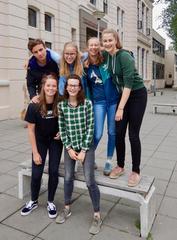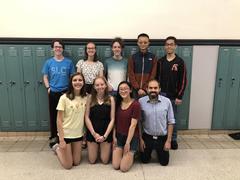The winning team from the Netherlands. Image: Martin Mug
Two teams of high-school students, one from Praedinius Gymnasium in Groningen, Netherlands, and one from West High School in Salt Lake City, USA, have won the 2019 Beamline for Schools competition (BL4S). In October, these teams will be invited to DESY to carry out their proposed experiments together with scientists from CERN and DESY.
Beamline for Schools is a unique international competition that is open to high-school students all over the world. The students are invited to submit a proposal for an experiment that uses a beamline. Beamlines deliver a stream of subatomic particles to any given set-up, making it possible to study a broad variety of properties and processes in various scientific disciplines. They are operated at laboratories such as CERN and DESY.
Since Beamline for Schools was launched in 2014 almost 10,000 students from 84 countries have participated. This year, 178 teams from 49 countries worldwide submitted a proposal for the sixth edition of the competition.
Due to the second Long Shutdown of CERN’s accelerators for maintenance and upgrade, there is currently no beam at CERN, which has opened up opportunities to explore partnerships with other laboratories, namely DESY.
“It is a great honour for us to host the finals of this year’s Beamline for Schools competition at DESY,” said Helmut Dosch, Chairman of the DESY Board of Directors. “We are really looking forward to meeting the extraordinary students who made it through with their proposals and we wish them a successful and rewarding time at the lab. We at DESY are committed to fostering the next generation of scientists, which CERN’s Beamline for Schools project does brilliantly.”
“We are all very excited to welcome this year’s winners to DESY. This is a new chapter in the history of this competition because, for the first time, we are taking the finals of the competition to another research laboratory,” said Sarah Aretz, BL4S project manager. “As always, the more then 60 voluntary experts from CERN and DESY evaluated all the proposals for their creativity, motivation, proposed methodology, feasibility and their overall ability to explore some of the concepts of modern particle physics.”
The two winning teams of 2019 will look at fundamental differences between matter and antimatter. When electrons at high energies collide with a target, such as a piece of graphite, some of their energy gets transferred into photons. These photons can, in turn, transform into other particles. Eventually, a shower of particles at lower energy will develop. The team “Particle Peers” from the Praedinius Gymnasium, Groningen, Netherlands has proposed to compare the properties of the particle showers originating from electrons with those created from positrons, the antimatter partner of the electron.
"I couldn't stop smiling when I heard the news that we’d won. It's unbelievable that we’ll get the opportunity to conduct our experiment with amazing scientists and meet new students who are just as enthusiastic about physics as I am," said Frederiek de Bruine from the “Particle Peers” team.
The “DESY Chain” team from the West High School, Salt Lake City, USA, focuses on the properties of scintillators in its proposal. These are materials that are used for particle detection. The students aim to study the performance of these scintillators and compare their sensitivity to electrons and positrons. This may lead to more efficient particle detectors for a wide range of applications.
“I’m so excited by the prospect of working at DESY this autumn, it’s such a once-in-a-lifetime opportunity. I’m proud to be a part of the first USA team to win the BL4S competition, especially because it provides access to equipment and systems I would otherwise never have dreamt of even seeing,” said August Muller from the DESY Chain team.
With their proposals, both teams went far beyond the physics curriculum of regular high schools and demonstrated their ability to understand some of the concepts of modern particle physics. This summer, the students will work together closely with scientists from CERN and DESY to prepare their experiments. In October, the winning teams will be welcomed to DESY to carry out their experiments and to get an insight into the life of a scientist.
The shortlist consisted of 20 teams, ten of which received a special mention. This is the second time that a Dutch team has won the competition. Previous winners came from schools in the Netherlands, Greece, Italy (twice), South Africa, Poland, the United Kingdom, Canada, India and the Philippines.
Beamline for Schools is an Education and Outreach project funded by the CERN & Society Foundation and supported by individual donors, foundations and companies. For 2019, the project is partially funded by the Wilhelm and Else Heraeus Foundation; additional contributions have been received from the Motorola Solutions Foundation, Amgen Switzerland AG and the Ernest Solvay Fund, which is managed by the King Baudouin Foundation.
In 2020, CERN’s accelerators will remain shut down for maintenance and upgrade. At the same time, the interest in the Beamline for Schools project is as high as ever. Several international research laboratories have expressed an interest in hosting the finals of the competition, with the result that a solution involving two locations, LNF in Italy and DESY in Germany, is being considered for the first time.
Videos of the winning teams:
Video from the team “Particle peers”, Praedinius Gymnasium in Groningen, Netherlands
Video from the team “DESY Chain”, West High School in Salt Lake City, US
The shortlist drawn up by CERN and DESY experts:
A Light in the Darkness from the United States
Centaurus Warriors from the United States
Cosmic Conquerors from Thailand
DESY Chain from the United States
DESYners from the United States
JT/High Pawns from Pakistan
Jubarte Team from Brazil
Leftover Leptons from India
Magic Doubly Magic Nuclei from Poland
My Little Positron from Australia
Particle peers from the Netherlands
Raiders of the Lost Quark from the United Arab Emirates
RAM FAM from Australia
Salvo Krevas from Malaysia
Team John Monash Science School from Australia
The Baryonic Six from Sweden
THE LUMINEERS from Pakistan
The Weak Force from South Africa
Unstoppable SPAS from China
Young Researchers from Ukraine
The following 10 teams received a special mention:
Antimatter Tracker from Argentina
Cherenkoviously Brilliant from the United Kingdom
EthioCosmos from Ethiopia
KICS TEAM from Sudan
Kleine Wissenschaftler from Iran
OBSERVERS OF THE MICROCOSM from Ukraine
Quantum Minds from Mexico
SolarBeam from Thailand
Team Pentaquark from Bangladesh
YKS_Young Kurdish Scientists from Iran
Further information
https://beamlineforschools.cern









